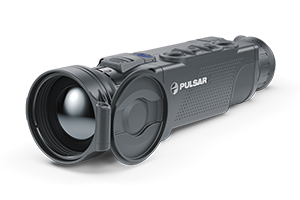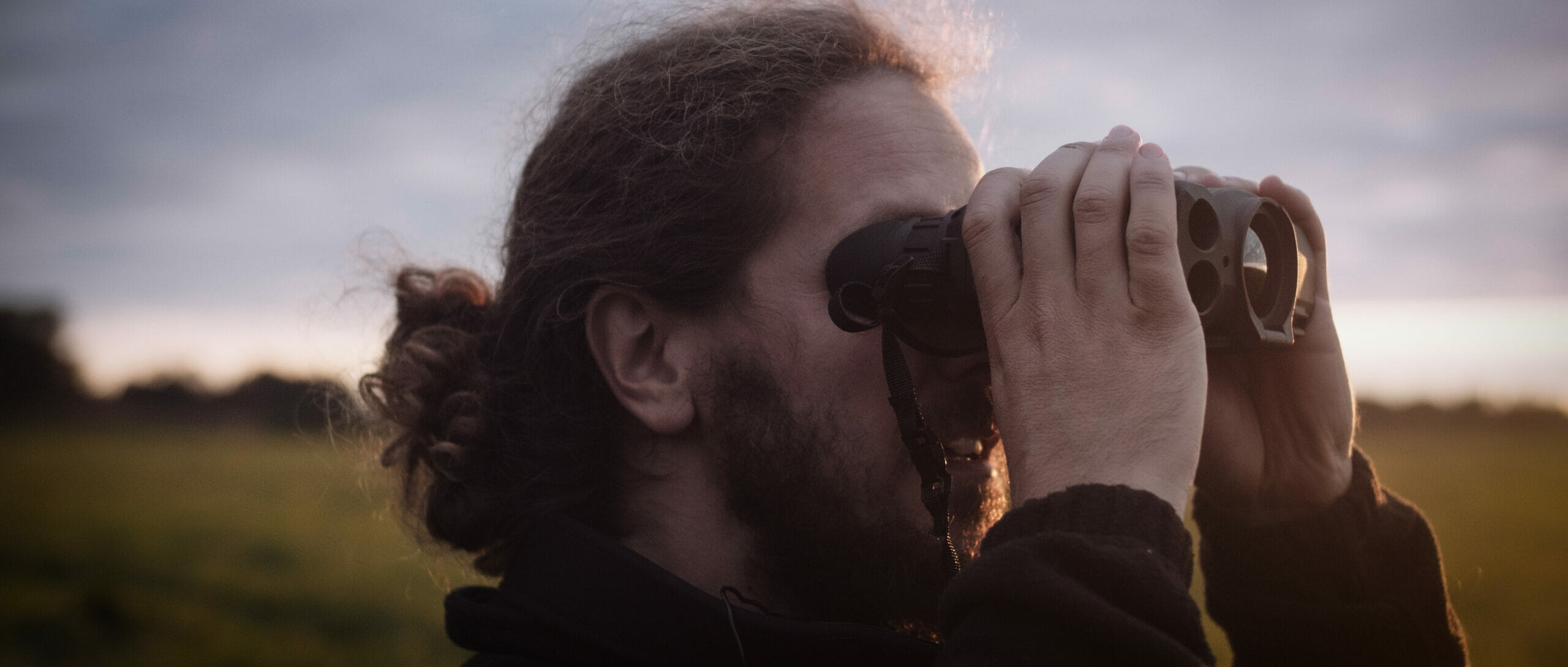
Mountbatten Hunting, Agnieszka Walczak and Alexandre Miliàn
mountbatten_hunting setkaingreenwonderland chasseurs_de_migrateursPhotography:
Pulsar Brand Ambassadors
There are many things bird hunters name when asked why they choose this type of outing. But we are always curious to hear personal stories, so we asked our brand ambassadors to tell us a little about their bird hunting rituals. If you, too, find bird hunting exciting, join us for a chat with Mountbatten Hunting from Germany, Alexandre Miliàn from France, and Agnieszka Walczak from Poland.
Our brand ambassador from Italy Riccardo Tamburini has recently got a really close view of a capercaillie. Recorded with his Thermion 2 LRF XP50 PRO, the video shows every detail of the bird clearly and vividly.
Why do you like hunting birds?
If you ask a bird hunter why they choose this particular type of hunt, they will have many reasons up their sleeve. The quality time you get to have with your friends, family, and the canines. The incredible views you get to observe while looking for game. The adrenaline rush, the long walks, and the delicious meals you take afterwards. Obviously, that was the first question we asked our brand ambassadors – why do you like hunting birds?
Mountbatten Hunting: Bird hunting means spending time with my wife, friends, and dogs, and that’s what I enjoy the most. Even though my hit ratio can certainly be improved, I enjoy those days very much.
Alexandre: I usually hunt birds overnight, and it’s always a surprise. Because I hunt migratory birds, one day, there might be none, and the next morning there would suddenly be the whole flock around. I think that the surprise element is my favorite. You have to be very patient and humble, but nature always has something in store for us.
Agnieszka: Hunting for birds really is surprising. You have to be vigilant and fast. You also need to be a good shooter to hunt a duck or a pheasant. There is a proverb in Poland: one package of ammo, one duck.
Bird hunting means spending time with my wife, friends, and dogs, and that’s what I enjoy the most. Even though my hit ratio can certainly be improved, I enjoy those days very much.
Mountbatten Hunting
In Europe, you will notice two main types of bird hunting: waterfowl and game birds. The most popular species of waterfowl are geese and ducks, mostly hunted throughout the wetlands of Central Europe, Western France, Northern Italy, and the Balkans. Grouse, partridge, pheasant, and quail are among the most popular game birds. In Europe, it is common for hunters to breed their own game birds and release them later. This is a popular way to ensure healthy population numbers while simultaneously always having something to shoot.
Which birds do our brand ambassadors hunt the most, and where do they mostly do it?
Alexandre: My favorites are migratory birds – usually woodcocks and ducks. I travel around France to discover new territories and new hunting methods, but my favorite place for hunting is my home – Landes, the South of France. I think because I know the area so well, it allows me to perform my absolute best.
Mountbatten Hunting: At home, we only have ducks, but we have friends who have pheasants on their grounds. They invite us over 3-4 times a year, and I’m always really happy to go there as we have a great time together.
Alexandre Miliàn
In certain French regions, we hunt ducks at night, and we spend the time hiding in huts at the edge of the water. Here, we patiently wait for the landing of a wild duck, following the song of our own ducks tied on the water.
Are there any unique aspects in countries where our ambassadors hunt?
In essence, hunting is the same wherever you go. But when you look at each country separately, we find quite a few differences and peculiarities. In Austria, it is extremely popular to go bird hunting in the mountains, spending hours hiking through adorable sceneries and stalking. Its neighboring countries – Hungary, Chech Republic, Slovakia – are known for their driven hunts.
Mountbatten Hunting: I think when it comes to hunting, there are few differences across countries. In Germany, it is important that the owner of the territory would hunt predators all year round to give pheasants and ducks a chance to survive.
Alexandre: In certain French regions, including mine, we hunt ducks at night, and we spend the time hiding in huts at the edge of the water. Here, we patiently wait for the landing of a wild duck, following the song of our own ducks tied on the water.
In many places, bird hunting is considered the “entry-level” hunt. Surely, it still requires lots of skill and patience, but, typically, it is more of a social event and one where you need comparatively less gear. That being said, if you don’t wish to come back home empty-handed, there will be some challenges to overcome.
What exactly are they?
Alexandre: Migratory bird hunting requires a lot of patience, and I would say that it can be quite challenging. Also, the lack of predictability. You have to get used to the fact that one day, you won’t see a single bird, and on another, there might be dozens flying around. The same goes with retrieving the game – I’ve walked miles to pick up one woodcock, but I’ve also had plenty land 100 meters away from my feet.
Mountbatten Hunting: To me, it’s certainly hitting the target.
Agnieszka: You have to be in good physical condition. During pheasant or duck hunting, I walk a lot of kilometers! Also, you must be very focused. The pheasant popping out of hiding will not wait for the shot to be fired – you have to make quick decisions and get a precise shot.
Whether to use thermal imaging or night vision devices during a bird hunt is, of course, a hunter’s choice. But if you do decide to take one with you, there are some important criteria to take into account. First, of course, is the image quality and long detection range – with birds, you never have much time, so spotting one as soon as possible is a great advantage. Then, there is the compactness and ease of use – bird hunting requires you to be able to move around freely, so you wouldn’t want to load yourself with a bunch of gear. Finally, if you’re after waterfowl, having a waterproof device is certainly an advantage. Our own favorites for bird hunting include the Accolade and Merger binoculars as well as the Helion and Axion scopes.
Which Pulsar device do our hunters like best for bird hunting?
Alexandre: All pulsar products are of high quality, and the choice is tough. But I mainly use the Helion 2 XP50 PRO because it allows you to observe and recognize species very easily at night without scaring the game. The option to film the birds is a nice addition, too. But to tell you the truth, I think all Pulsar products would work for waterfowl hunting.
Agnieszka: I don’t use a Pulsar device for bird hunting, but I do need one when hunting for wild boar. For this, I mainly use the Pulsar Axion 2 LRF XQ35, and it’s fantastic to observe birds at night while waiting for the wild boars to come.
I mainly use the Helion 2 XP50 PRO because it allows you to observe and recognize species very easily at night without scaring the game. The option to film the birds is a nice addition, too.
Alexandre Miliàn

What part do dogs play in our brand ambassadors hunts?
When it comes to bird hunting, there is one more thing, essential for a successful outing – a well trained dog. Labrador Retrievers, German Pointers, Vizslas and English Springer Spaniels are among the most popular breeds for the task, but, with the right training, many other breeds can successfully point and retrieve the game.
Mountbatten Hunting: Yes, we take our two Golden Retrievers with us. They are responsible for tracking and retrieving the birds now, but it was quite hard to teach them to fetch the game when it’s really far away, and the dogs didn’t see where it fell.
Alexandre: I have three English Setters that I take woodcock hunting with me, and their job is to point to the bird and then bring it back to me. For ducks, I have a young Labrador whose main task is to retrieve them day and night, on land and from the water.
As for training, I wouldn’t say it was too hard, but you need a lot of patience for it. It takes a while for the dog to understand what you expect from it, and you have to help it understand.
Agnieszka: I don’t have a dog, but I can’t imagine duck or pheasant hunting without a well-trained dog. Fortunately, I have the pleasure of hunting with my friends, who have great hunting dogs making bird hunting unforgettable.
Even if you don’t intend to hunt birds, having a thermal imaging device can be useful when observing them. Our friend Boris Belchev, an ornithologist from Lithuania, uses Accolade 2 LRF PRO for both his work and the tours he leads. He told us all about it a little while ago, and you can find the full article here, but here’s an excerpt:
Boris: Now, when there are devices created for nature lovers and scientists, I am really happy to take advantage of them. Before that, no matter what kind of equipment or optics I had, I couldn’t always see a bird upon looking at a tree, and now I can clearly see each one of them. This has fundamentally changed my vision of nature and helped me see how much there is going on around us.
I also organize owl watching, and Pulsar binoculars are extremely useful for this, too. With them, I can show my guests so much more – until now, I would have to drive around the forest, use a flashlight, and hope that the owl’s eyes will reflect the light at some point. Now, I can find them without disturbing them at all, use my phone screen to show people where they are, and then allow my guests to watch the birds themselves.
Agnieszka Walczak
You have to be in good physical condition and very focused. The pheasant popping out of hiding will not wait for the shot to be fired – you have to make quick decisions and get a precise shot.
Before purchasing any night or thermal vision device, please make sure you adhere to the local legislation and only use it when it is allowed. Our ambassadors come from various countries and travel a lot, which allows them to test different devices. We do not encourage or support the illegal use of our devices in any events. If you wish to learn more about export and sales restriction policy, please visit the following link: Export and Sales Restriction Policy.

